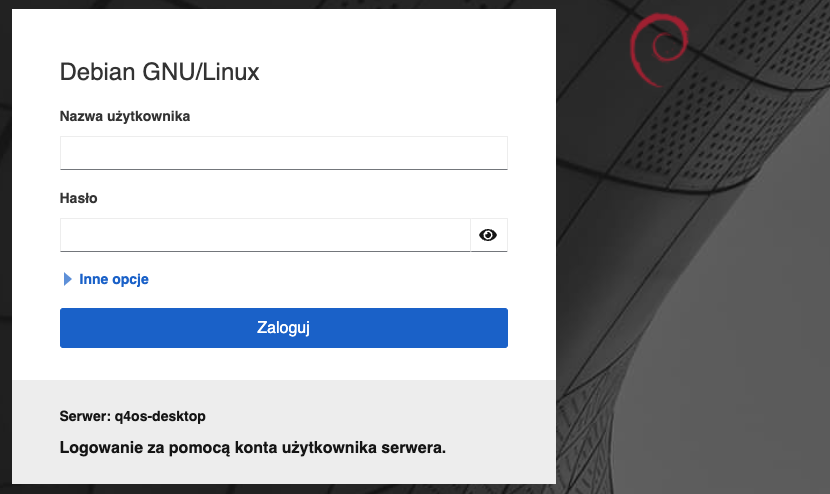Podman, cockpit
Podman = Docker
Podman, cockpit na przykładzie waifu2x, nunif
Instalacja w Debianie:
sudo apt install podman cockpit-podman
Zalecane:
sudo apt install gettext nodejs make
. /etc/os-release
echo "deb http://deb.debian.org/debian ${VERSION_CODENAME}-backports main" > \
/etc/apt/sources.list.d/backports.list
apt update
apt install -t ${VERSION_CODENAME}-backports cockpit
Sprawdzamy:
sudo systemctl status cockpit
● cockpit.service - Cockpit Web Service
Loaded: loaded (/lib/systemd/system/cockpit.service; static)
Active: inactive (dead)
TriggeredBy: ● cockpit.socket
Docs: man:cockpit-ws(8)
O usługa nie działa (dead), załączamy:
sudo systemctl enable --now cockpit
....😕
sudo systemctl enable --now cockpit
The unit files have no installation config (WantedBy=, RequiredBy=, Also=,
Alias= settings in the [Install] section, and DefaultInstance= for template
units). This means they are not meant to be enabled using systemctl.
Possible reasons for having this kind of units are:
• A unit may be statically enabled by being symlinked from another unit's
.wants/ or .requires/ directory.
• A unit's purpose may be to act as a helper for some other unit which has
a requirement dependency on it.
• A unit may be started when needed via activation (socket, path, timer,
D-Bus, udev, scripted systemctl call, ...).
• In case of template units, the unit is meant to be enabled with some
instance name specified.
....😱
sudo systemctl status cockpit
● cockpit.service - Cockpit Web Service
Loaded: loaded (/lib/systemd/system/cockpit.service; static)
Active: inactive (dead) since Wed 2023-09-20 20:04:50 CEST; 1min 1s ago
TriggeredBy: ● cockpit.socket
Docs: man:cockpit-ws(8)
Process: 60886 ExecStartPre=/usr/lib/cockpit/cockpit-certificate-ensure --for-cockpit-tls (code=exited, status=0/SUCCESS)
Process: 60899 ExecStart=/usr/lib/cockpit/cockpit-tls (code=exited, status=0/SUCCESS)
Main PID: 60899 (code=exited, status=0/SUCCESS)
CPU: 217ms
wrz 20 20:03:20 q4os-desktop systemd[1]: Starting Cockpit Web Service...
wrz 20 20:03:20 q4os-desktop cockpit-certificate-ensure[60893]: /usr/lib/cockpit/cockpit-certificate-helper: line 25: sscg: command not found
wrz 20 20:03:20 q4os-desktop cockpit-certificate-ensure[60894]: Generating a RSA private key
wrz 20 20:03:20 q4os-desktop cockpit-certificate-ensure[60894]: ..........................................................+++++
wrz 20 20:03:20 q4os-desktop cockpit-certificate-ensure[60894]: .......................+++++
wrz 20 20:03:20 q4os-desktop cockpit-certificate-ensure[60894]: writing new private key to '0-self-signed.key'
wrz 20 20:03:20 q4os-desktop cockpit-certificate-ensure[60894]: -----
wrz 20 20:03:20 q4os-desktop systemd[1]: Started Cockpit Web Service.
wrz 20 20:04:50 q4os-desktop systemd[1]: cockpit.service: Succeeded.
po chwili 😀
sudo systemctl start cockpit
lmk@q4os-desktop:~$ sudo systemctl status cockpit
● cockpit.service - Cockpit Web Service
Loaded: loaded (/lib/systemd/system/cockpit.service; static)
Active: active (running) since Wed 2023-09-20 20:11:50 CEST; 1min 2s ago
TriggeredBy: ● cockpit.socket
Docs: man:cockpit-ws(8)
Process: 61024 ExecStartPre=/usr/lib/cockpit/cockpit-certificate-ensure --for-cockpit-tls (code=exited, status=0/SUCCESS)
Main PID: 61025 (cockpit-tls)
Tasks: 8 (limit: 9419)
Memory: 1.8M
CPU: 1.517s
CGroup: /system.slice/cockpit.service
└─61025 /usr/lib/cockpit/cockpit-tls
Sprawdzamy, czy cockpit się odpalił na porcie http://localhost:9090:

Działa 😀 😀 😀
Tworzenie obrazu:
podman build -t python -f podmanfile
STEP 1: FROM python:latest
Error: error creating build container: short-name "python:latest" did not resolve to an alias and no unqualified-search registries are defined in "/etc/containers/registries.conf"
-f oznacza plik, inaczej pokazuje, że nie znajduje katalogu,
-t nadaje nazwę (tag) obrazowi kontenera jako "python".
Musimy dopisać skąd, będziemy pobierać obrazy w pliku "/etc/containers/registries.conf":
Oficjalne źródło to Docker hub (innych narazie nie znam):
[registries.search]
registries = ['docker.io']
i restartujemy usługę:
sudo systemctl restart podman
Uruchomimy kontener w trybie interaktywnym i wcześniej budujemy image:
podman build -t nazwa_obrazu -f podmanfile && \
podman run -it nazwa_obrazu /bin/bash
Podmanfile kod na przykładzie nunif:
FROM nvidia/cuda:11.8.0-runtime-ubuntu22.04
MAINTAINER nagadomi <[email protected]>
# install deps
RUN apt-get update -y && apt-get install -y git-core python3-pip libmagickwand-dev libraqm-dev
# install
RUN git clone https://github.com/nagadomi/nunif.git /root/nunif && \
cd /root/nunif && \
pip3 install torch torchvision torchaudio torchtext && \
pip3 install -r requirements.txt && \
python3 -m waifu2x.download_models && \
python3 -m waifu2x.web.webgen.gen
WORKDIR /root/nunif
Uruchamianie nunif:
podman run -p 0.0.0.0:8812:8812 -it nunif001 /bin/bash
python3 -m waifu2x.web --port 8812 --bind-addr 0.0.0.0 --no-size-limit
Przenoszenie obrazu:
Eksport obrazu do archiwum tar
podman save -o obrazy.tar nazwa_obrazu
Przenieś plik obrazy.tar na inny komputer i zaimportuj obrazy
podman load -i obrazy.tar
Obrazy Podman są przechowywane w katalogu ~/.local/share/containers
Cofamy się w instrukcji i odpalamy na innym komputerze.
Czym jest waifu2x:
Linki (pomoce) do podmana i cockpitu